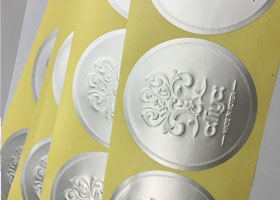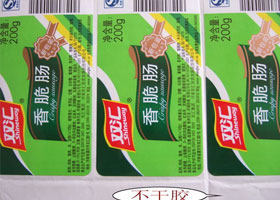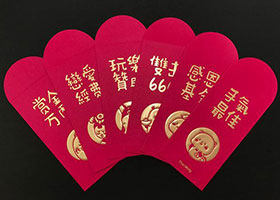The small label is often an important embodiment of the company's image and brand. It plays an important role in reflecting the quality of the product and causing consumers' desire to buy. Here we have to mention the printing of the label. This article shares Related knowledge of self-adhesive printing, for your friends' reference:
Precautions
1. For cylindrical bottles, especially those with a diameter of less than 30 mm, the material should be chosen carefully.
2. If the label size is too large or too small, you should pay attention to the actual test.
3. If the object to be attached is an irregular surface or even a spherical surface, there are specific considerations for the type, thickness and adhesive of the label material.
4. Some rough surfaces such as corrugated boxes will affect the labeling, and the varnish on the surface of the corrugated boxes will also have an effect.
5. Automatic labeling machine label, labeling test can be conducted if necessary.
6. Even if the label is applied at room temperature, pay attention to whether it is exposed to high temperatures during export transportation or use.
7. A lot of water or oily environment will affect the characteristics of the adhesive. Pay attention to the environment and temperature of the label.
8. Sometimes plasticizer will bleed out on the surface of soft PVC, so special attention should be paid to choosing a suitable adhesive.
Printing process
1. Most adopt the same process. The process of self-adhesive printing is mainly carried out at one time on the label machine, which means that one machine can complete many different processes of label printing.
2. The self-adhesive processing is carried out on-line, so the quality control is a comprehensive issue. It needs to be considered and implemented from the aspects of material selection, equipment configuration and regulation, and the formulation of process routes. The application of label products to users to improve the quality of labels.
3. In the selection of raw materials, high-quality self-adhesive materials with all physical and chemical indicators will be selected, and will not be adopted because of the low price of failed materials. Inferior raw materials are inherently unstable in quality, and have a greater chance of causing the equipment to fail to process normally, thereby wasting resources and manpower, and causing losses to customers and losing customers. Therefore, in the selection of raw materials, the selection of materials has strict standards. You can rest assured to buy and place orders.
Embossed
It uses relief printing to print self-adhesive labels, and the printing plates are photosensitive resin relief plates. The printed labels have the advantage of full ink color, but now the level of relief printing equipment is quite different, and some still use circular flattening relief printing machines, and some use ordinary Some of the rotary embossing machines have adopted professional oblique back, satellite or unit type label printing machines, so they cannot be generalized during the transformation. Professional self-adhesive printing machines mainly based on relief printing have the ability to print film labels, but they need to contact the supplier to replace some related parts, such as adding a tension control system controlled by a servo motor, adding a film surface treatment unit, high-end Some machines can also add a precise registration system.

Offset Printing
Offset printing is the main method used by Chinese label printers to print paper stickers. The characteristics of offset printing are fine graphics and rich layers, suitable for mass printing, and the printing equipment can be used in one machine, suitable for the characteristics of the Chinese label market. However, sheet-fed offset printing is not suitable for printing films with no absorption on the surface, because film labels are mostly roll-to-roll printing, which requires volatile dry ink. Offset printing can print thicker plastic materials, such as in-mold labels and label hang tags, but the machine must be equipped with a UV curing device, which requires a large fee.

Flexo
At present, the quality of flexographic printed matter is no less than that of offset printing, and even has its unique features. This printing process has the advantages of simple machine structure, low cost, comparable printing quality to offset printing and gravure printing, and has the advantage of being thicker than the ink layer of offset printing products. Flexographic printing uses water-based ink and uv ink without polluting the environment. However, due to the greater flexibility of the flexographic version, the tone reproducibility is different from that of intaglio and ordinary letterpress. The dots from the highlight to the middle tone of the flexographic printing increase greatly, the contrast of the printing is small, and the highlight layer is prone to fault. In order to make up for the defects of the layer when labeling, FM dots can be used in the highlight part, dark tone or amplitude modulation screen is called in the middle to improve the quality. A label printing plant without a flexo printing machine can introduce a laminated narrow-width flexographic printing machine dedicated to self-adhesive label printing, which is suitable for film label printing. Because flexographic printing presses use round die-cutting, die-cutting rollers are expensive, and the production cycle is long. They are only suitable for long-type jobs, and are not suitable for the characteristics of large domestic demand for short-label stickers. But it is an easy-to-transform label printing equipment that can work online with the film slitting, stitching, and sealing processes
Due to the continuous improvement of label printing technology, the problem that the old flat press die cutting machine cannot continuously feed paper has been solved. The speed, automatic registration, post-press online work and other functions can already be combined with the mature round press die cutting On a par with the machine, since the die cutter of the flat die cutting machine is easy to produce, has a short cycle and low price, the production cost can be greatly reduced in short-term work.

Gravure
Gravure printing adopts short ink path inking system for ink supply, web printing, high degree of automation, using solvent-based ink, the ink layer dries quickly, is the first choice for film printing. Generally, the speed of gravure printing machine is relatively high, and the rear end of many gravure printing machines is also equipped with a cylinder die cutting device, which can perform die cutting and indentation, and is suitable for the printing of various labels. However, due to the long gravure plate-making cycle and expensive plate-making cost, it is only suitable for large-scale label production.
Adhesives
The water content of self-adhesive labels is water glue and hot-melt adhesive. Because hot-melt adhesive equipment has the advantages of small size and low price, and hot-melt adhesives are environmentally friendly, intensive, repeatedly bonded, recyclable and easy to operate during the operation process And other advantages, making it more and more widely used in the field of labels. The process of hot melt adhesive equipment is composed of several parts: unwinding-coating-cooling-compounding-winding.
Printing Bronzing
As an important metal effect surface finishing method, hot stamping is an effective way to enhance the visual effects of products such as trademarks, cartons, and labels, and is widely used. The two main hot stamping methods, hot stamping and cold stamping, have their own advantages and disadvantages. In practical applications, the appropriate stamping method should be selected according to the specific situation, mainly based on cost and quality. Hot stamping technology refers to the use of special metal hot stamping plates to transfer hot stamping foil to the surface of the printing material by means of heating and pressure.
The advantages of hot stamping technology mainly include the following points, good quality, high precision, clear and sharp edges of hot stamping images. The surface gloss is high, and the hot stamping pattern is bright and smooth. There is a wide selection of hot stamping foils, such as hot stamping foils of different colors, hot stamping foils with different gloss effects, and hot stamping foils suitable for different substrates. The three-dimensional hot stamping plate is made by the method, so that the graphics processed by the hot stamping have a clear three-dimensional level, forming a relief effect on the surface of the printed product, and generating a strong visual impact effect. Three-dimensional hot stamping can make the packaging have a unique touch. It is precisely because of the above-mentioned advantages of the hot stamping process that it is favored by the majority of users and consumers and is widely used. However, the hot stamping process requires special equipment, a heating device, and a hot stamping plate. Therefore, obtaining a high-quality hot stamping effect also means paying a higher cost.
Cold hot stamping technology does not require special hot stamping equipment, and the price of these equipment is usually relatively expensive. There is no need to make metal hot stamping plates, and ordinary flexible plates can be used. Not only the plate making speed is fast, the cycle is short, but also the production cost of hot stamping plates can be reduced. Fast stamping speed, up to 450fpm. No heating device is needed, and energy can be saved. A piece of photosensitive resin plate can be used to complete the hot stamping of the mesh tone image and the solid color block, that is, the mesh tone image and the solid color block to be hot stamped can be made on the same hot stamping plate. Of course, just as the mesh tone and the solid color block are printed on the same printing plate, the hot stamping effect and quality of both may have a certain loss. The hot stamping base material has a wide range of applications, and can also be used on heat-sensitive materials, plastic films, and in-mold labels. In short, the difference, advantages and disadvantages of blanching and cold blanching are more obvious. In actual production, the choice of hot stamping technology or cold stamping technology should be based on specific circumstances. Using hot stamping technology can achieve the best stamping quality and stamping effect, but the cost is higher. Although the quality of cold stamping is not bad, it is inferior to hot stamping, but the cost is lower.

Post-process editing
In order to protect the printed patterns of the self-adhesive labels and improve the quality of the labels, many self-adhesive labels have chosen surface finishing such as laminating, glazing and bronzing after printing. According to the processing method of self-adhesive labels, the bronzing method is divided into sheet bronzing and roll paper bronzing. The single-sheet bronzing process is the same as the traditional bronzing process and is processed on a dedicated bronzing machine. Roll paper bronzing is done on the label linkage, which is the most widely used processing method.
There are several ways to reel material bronzing:
①Flat stamping on the labeling machine
②Multi-station flat pressing bronzing
③Flat stamping on the processing machine
④Circular hot stamping on the rotary machine
⑤ Cold bronzing on the rotary machine This is a new bronzing process. Instead of using heated metal printing plates, the method of printing adhesive is used to transfer the metal foil to achieve bronzing.
The process flow is: first print the UV pressure-sensitive adhesive at the position where the stamping needs to be gilded, dry the adhesive through the UV drying device, and then use special metal foil to combine with the pressure-sensitive adhesive, and then peel off the metal foil, so the metal The part of the foil that needs to be transferred is transferred to the surface of the printed product to achieve cold bronzing. The cold bronzing process has low cost, saves energy, and has high production efficiency. It can use existing equipment parts without adding additional devices. It is a promising new process.
The glazing and glazing process is mainly applied to the surface coating of mirror coated paper and coated paper labels, the purpose is to increase the glossiness of the surface, and to achieve the functions of anti-fouling, anti-humidity and protection of patterns. According to the processing method, the glazing of self-adhesive label materials is divided into single-sheet glazing and web glazing, of which web glazing is the most commonly used method in the printing process of adhesive labels. The coating of web stickers is carried out on a rotary labeling machine. The UV glazing process is generally used, that is, a layer of UV varnish is evenly coated on the patterned surface after printing. For water-based ink flexo labels, glazing is an essential process.
Laminating film with bottom paper composite film-on the labeling machine, using a special composite film with bottom paper, under the action of the composite device to cover the film. This is a traditional laminating method. It has been replaced by the process of using bottomless composite film. Backing paper composite film compounding-carried out on the labeling machine, the principle of laminating is basically the same as the backing paper composite film compounding process. The bottomless paper film replaces the base paper after rewinding by the surface smoothness (surface tension) of its own material. After the adhesive is adhered to its surface, it can also be peeled off without leaving traces of glue. The material used for the bottomless paper film is a low surface tension BOPP film. The bottomless paper film has low cost and is currently the most widely used film material.
Printing-silk Screen Security
1. The anti-counterfeiting of anti-counterfeit labels by silk screen mainly refers to anti-counterfeiting for the coating parts and parts.
2. It is recommended that the coating part should not be coated as much as possible, because the coating cost is high and it is not easy to cut, varnish is the best way.
3. When making self-adhesive labels, try not to apply varnish as a whole, just part of it.
4. The thickness of the screen mesh screen affects the thickness of the coating, and the density of the thinner affects the appearance of the coating.
5. The silk screen anti-counterfeiting technology of self-adhesive labels uses water-based screens for dripping anti-counterfeiting, and the others are generally oily.
6. The screen mesh of the screen printing is generally 250-350 mesh. In theory, the larger the screen mesh, the thicker the effect and the thicker the coating.
7. In actual use, it was found that the thicker the ink, the more detailed the screen printing pattern. If the dilution is not enough, it may rise.
8. Screen printing is related to layout and design. The larger the layout space, the better the position adjustment during screen printing. Screen printing is also related to the weather. Too wet or too high temperature will affect the effect of screen printing. Generally, when the temperature is high, dry water or slow 783 should be added. When the temperature is low, dry water should be accelerated.
9. The silk screen should pay attention to the requirements of the customer's single label and the coding. If the coating is thin on the coating, it does not matter; if the coating is not printed, the coating should be thick; the other is the coding. When the font is as clear as possible, strokes should be as fine as possible.
10. The silkscreen has a relationship with the order of label placement: those with serial numbers and those without serial numbers should pay attention to distinguish them.
11. Screen printing should pay attention to the problem of materials. Different materials have different inks and practices.
12. The silk screen should pay attention to whether it needs to be laminated in the subsequent processing. If the silk screen part is easy to fall off or wipe off, it should be laminated.
13, silk screen should pay attention to whether to register, generally offset printing is better, but often silk screen printing can not be printed offset printing can be printed, so, often said that silk screen is omnipotent.
14. The screen printing technology of the self-adhesive label should understand the performance of the ink, and must understand the screen, position, adjustment, repair and washing.
15. The silk screen should pay attention to the surface not to be pasted or blistered;
16. It is worth reminding that it is generally recommended to do it all at once when doing drip anti-counterfeiting, because this kind of screen often has a pause in the middle and may not be available.
17. The silk screen should be made according to the production order. If the temperature change anti-counterfeiting should pay attention to whether the temperature change disappears, or the temperature change discolors; pay attention to whether the temperature change effect is reversible or irreversible.
18. The standard for measuring the performance of silver powder on the surface of the silk screen is: it can be scraped off with nails and cannot be wiped off with the fingertips.
(This article is reproduced from the network)





